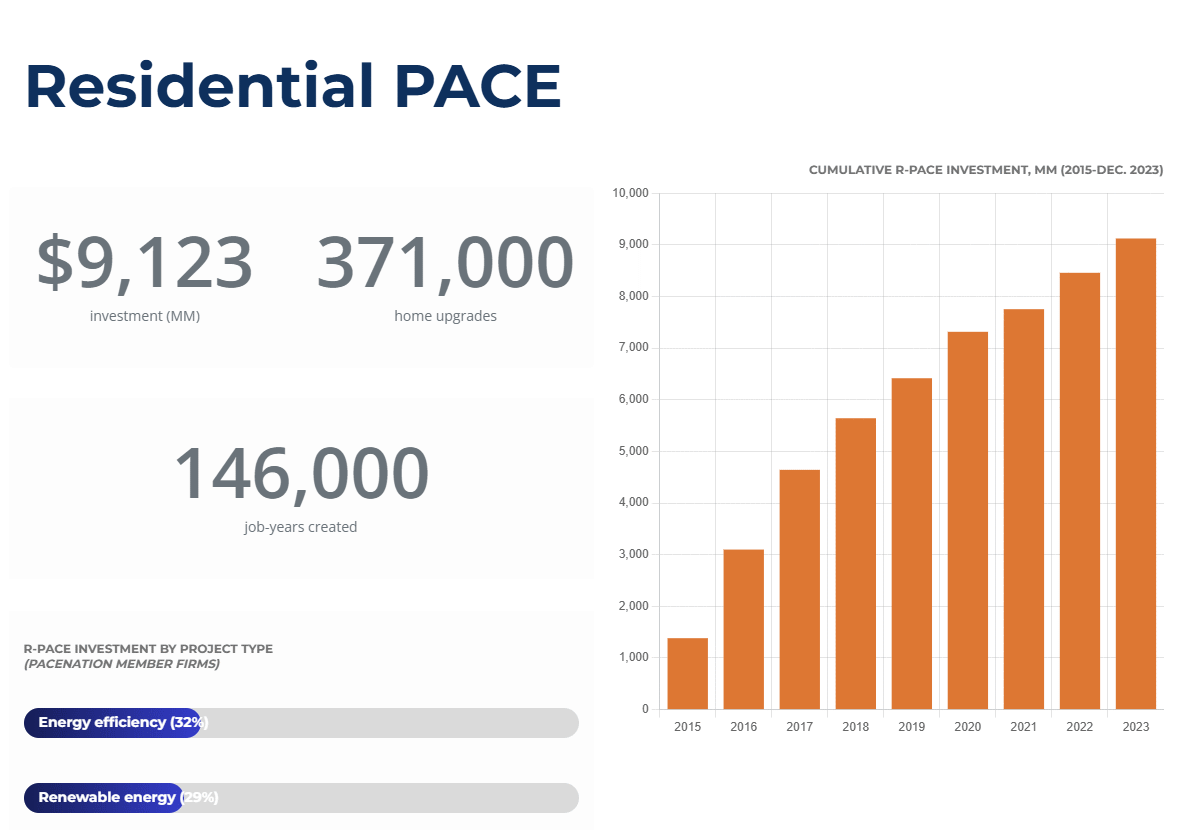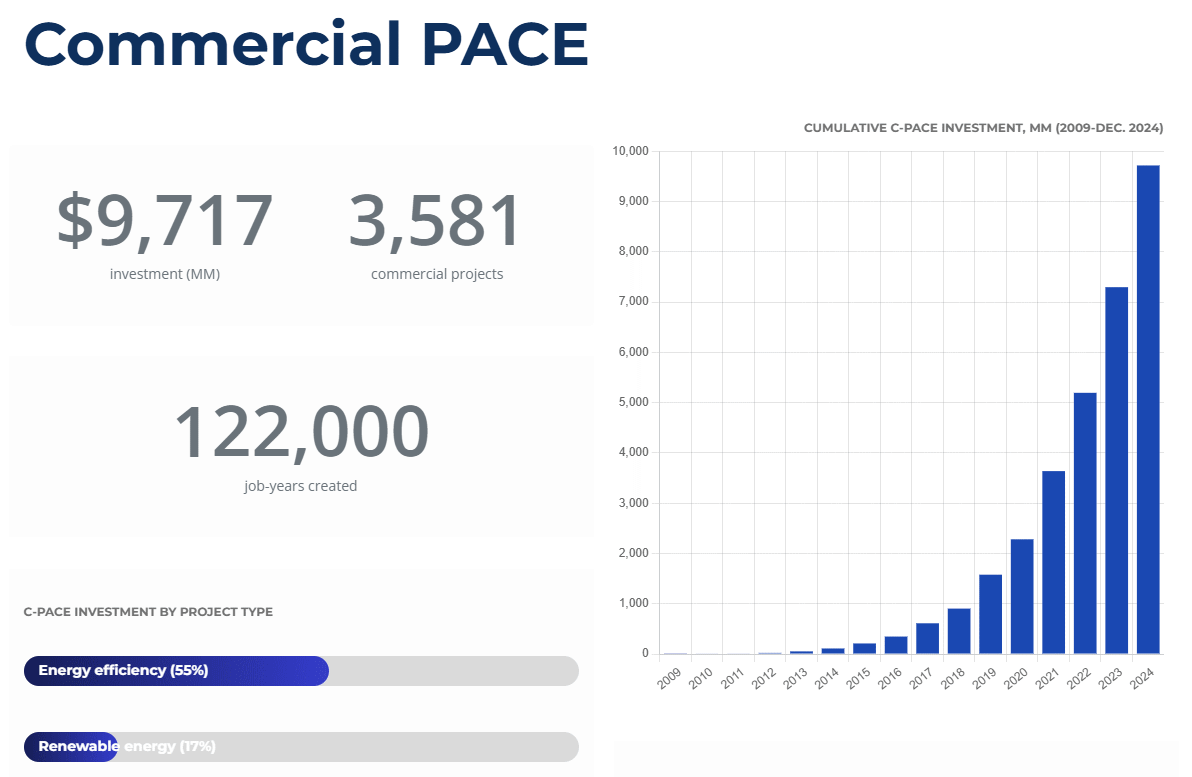
IMAGINE A WORLD WHERE RENEWABLE ENERGY AND
ENERGY EFFICIENCY UPGRADES ARE PROFITABLE FOR BUSINESSES AND AFFORDABLE FOR HOMEOWNERS
PACE CREATES THAT WORLD
Property Assessed Clean Energy (PACE) is a proven financing tool
that building owners and developers can use to:
1) upgrade their building's energy performance,
2) install renewable energy systems, and
3) reduce resource consumption
with no money down and
with the financing repaid through their property's tax bill.
According to the IPCC, global warming is accelerating 26% faster since 1970 and greenhouse gas reduction measures need to be sharply increased in both scope and scale if we are to avoid an unsustainable future. While PACE financed energy efficiency and renewable energy measures in the USA are making a significant impact (nearly 19 Billion dollars invested in over 384,000 projects), Canadian PACE programs are seriously underperforming. To find out why we are lagging behind and to help us send a message to the Federal Government on how to make PACE perform as it should, click on this link.
UNDERSTANDING THE POWER OF PACE
PACE (Property Assessed Clean Energy) is both a financing tool and an ecosystem. While there is no doubt that PACE is a game changing Climate Change tool that both unleashes unlimited green capital investments and mobilizes the private sector to become Climate Change champions, it only does so when properly understood and implemented.
PACE The Tool: Property owners borrow 100% of the upfront costs of implementing energy savings and renewable energy measures, and then repay the loan over the life of the upgrades, making it affordable for homeowners and profitable for businesses.
PACE The Ecosystem: Consultants, developers, contractors, suppliers, lenders, service providers and government organizations are all motivated to promote, facilitate, and deliver PACE enabled upgrades to their clients and constituents.
PACE makes it easy for homeowners to upgrade their homes, and attractive for businesses to reduce their energy and carbon footprint, all while making it profitable for the private sector to invest and provide GHG reduction goods and services. PACE is a classic Win-Win scenario.
Watch short
RESIDENTIAL r-PACE &
cOMMERCIAL C-PACE videos
PACE's popularity and growth in the USA has been exponential, and since 2008 it has financed over 383,000 home and commercial retrofits with nearly 19 billion dollars (over 37 billion economic impact), and created over 270,000 job years; all without one penny of taxpayer support (PACE Market Data).



PACE Alberta advocates emulating the US PACE model in Alberta and across Canada. Why? Because it has proven itself to be extremely successful at motivating home and business owners to implement significant renewable energy and energy efficiency measures without requiring government grants. The US PACE model has achieved this success due to several key factors which the legislative framework must enable and facilitate:
-
PACE loan capital is sourced primarily from private funds (ensuring that every qualified application can be funded without delay upon approval);
-
The PACE legal framework creates the foundation for a PACE ecosystem designed to ensure that private-sector players (funders, administrators, consultants, contractors) actively engage in promoting and delivering PACE financing and services;
-
Recognition that Residential PACE and Commercial PACE are related but distinct programs in which:
-
R-PACE is simple for the homeowner to quickly review and get approved, profitable for contractors to promote, and governed by a robust homeowner protection program; and
-
C-PACE is delivered with a minimum of administrative overhead and review, relying instead on the due diligence of PACE funders and C-PACE borrowers to undertake suitable financial viability analysis prior to funding.
-
-
Governments limit their involvement to residential consumer protection oversight and program compliance by private sector players
-
Municipalities limit their engagement to collection of the PACE loan payments and transfer all other PACE administrative responsibilities to third party administrators.
Jurisdictions in the USA that have adhered to proven PACE financing best practices have seen PACE dramatically accelerate the implementation of GHG-reducing measures in residential and commercial buildings, while jurisdictions that have failed to do so have seen their PACE programs underperform at best or simply die for lack of interest.
Although the PACE financing tool appears straightforward, the PACE enabling legislation plays a crucial role in nurturing a thriving and robust PACE ecosystem. When the enabling legislation is based on success, it fosters a mutually beneficial environment for all stakeholders involved. PACE leverages the private sector's profit motive to support public sustainability goals, creating a large contingent of advocates and champions who encourage, educate, and persuade clients to upgrade their homes and business facilities.
To learn more about the traits of a successful PACE program, refer to the Canadian Home Builders Association's "What is a Net-Zero Home" page and scroll to the Helping Homeowners with the Cost of Net Zero Energy section where you will find an banner titled "More About PACE". Open the banner to read the report titled "Keys to Developing a Successful PACE Financing Program."
PACE FOR EVERYONE
PACE BENEFITS
PACE upgrades can lower electric, gas and water utility bills, reduce resource use and consumption, and result in healthier more comfortable buildings with improved indoor air quality.
1.
PACE financing for new buildings will incentivize developers to upgrade their designs; potentially economically developing new buildings that are net-zero and even net-positive or regenerative.
3.
Municipalities and building owners benefit from increased property values, marketability, and economic activity.
2.
PACE can cover thousands of energy saving enhancements including solar panels and modules, insulation, roof shingles, high performance windows, high-efficiency furnaces, heat pumps, and geothermal exchange systems.
4.
